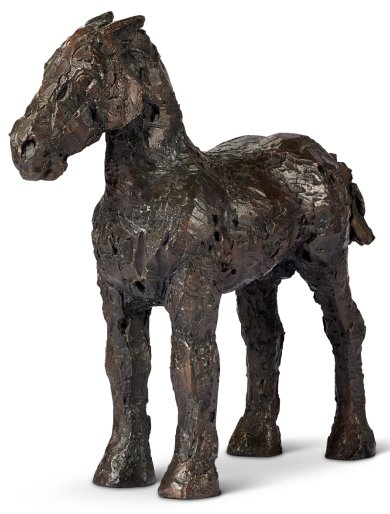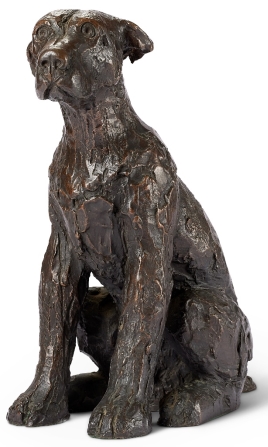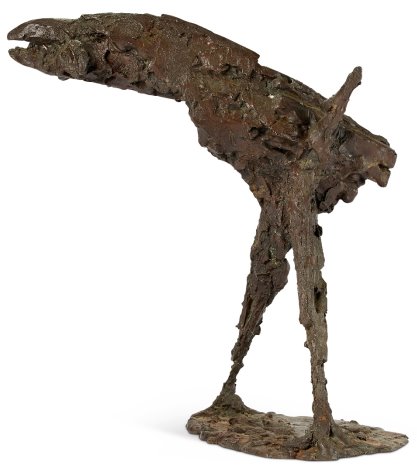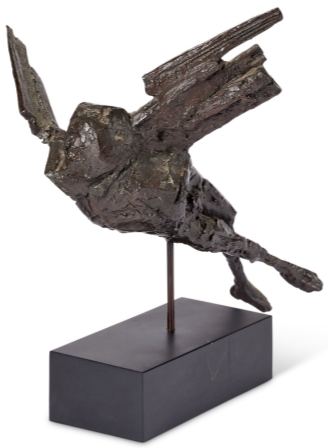Last known Elisabeth Frink sculpture in auction
 The last known work ever produced by one of Britain’s greatest sculptors, Dame Elisabeth Frink (1930–1993), is to be offered at auction. The sculpture titled Standing Horse was produced by Royal Academician Frink in 1993, just before she died in the same year. The piece is a highlight of a Modern and Contemporary Art sale on March 15 at Dreweatts.
The last known work ever produced by one of Britain’s greatest sculptors, Dame Elisabeth Frink (1930–1993), is to be offered at auction. The sculpture titled Standing Horse was produced by Royal Academician Frink in 1993, just before she died in the same year. The piece is a highlight of a Modern and Contemporary Art sale on March 15 at Dreweatts.

The horse theme ran consistently throughout Frink’s oeuvre, with her father having been an amateur jockey and the sculptor growing up in the countryside surrounded by animals. This instigated a passion for encapsulating horses, dogs and birds with a depth of meaning, rather than purely as naturalistic subjects. Frink harboured a long-standing respect for how horses helped man throughout history, from their roles in agriculture to their participation in war. As well as her fondness for the animal, they came to represent her exploration of nature and humanity.
In Standing Horse Frink cleverly communicates the animal’s reliability by the casting in heavy bronze and its sturdy nature. Standing Horse is part of the Jean Marsden private collection of works by Frink in the sale, which features works from across her career, from the 1950s right up to the 1990s. Standing Horse is 36.5 cm x 44cm and is estimated to fetch £40,000-£60,000.
 Also in the collection is a charming bronze sculpture of a dog, which was commissioned (by The Morris Singer Foundry Ltd. in Hampshire), to be sold in aid of Great Ormond Street Hospital. Frink explored the subject of dogs in the late 1980s and early 1990s. She looked to explore the unique relationship between dogs and man, which was something she witnessed first-hand through her husband Alex Csaky, who owned Hungarian gun-dogs. These magnificent working dogs were muscular in build, with smooth coats, which lent themselves well to being captured in sculpture. Commenting on the work Francesca Whitham Picture Specialist at Dreweatts, said: “What is particularly striking is the way in which Frink captures the personality and character of the dog. We feel a sense of affection as the dog focuses outwards, sniffing the air with wide eyes, looking expectantly at his master.” Dog was cast in 1993, is numbered 002 and stamped Great Ormond Street/Children’s Hospital/charity edition to the underside. It is estimated to fetch £60,000-£80,000.
Also in the collection is a charming bronze sculpture of a dog, which was commissioned (by The Morris Singer Foundry Ltd. in Hampshire), to be sold in aid of Great Ormond Street Hospital. Frink explored the subject of dogs in the late 1980s and early 1990s. She looked to explore the unique relationship between dogs and man, which was something she witnessed first-hand through her husband Alex Csaky, who owned Hungarian gun-dogs. These magnificent working dogs were muscular in build, with smooth coats, which lent themselves well to being captured in sculpture. Commenting on the work Francesca Whitham Picture Specialist at Dreweatts, said: “What is particularly striking is the way in which Frink captures the personality and character of the dog. We feel a sense of affection as the dog focuses outwards, sniffing the air with wide eyes, looking expectantly at his master.” Dog was cast in 1993, is numbered 002 and stamped Great Ormond Street/Children’s Hospital/charity edition to the underside. It is estimated to fetch £60,000-£80,000.
 During the second World War Frink lived near an RAF base in Suffolk and became fascinated by the concept of flight and freedom, as she witnessed planes flying overhead, sometimes close to the ground. Flight would become a recurring theme as she examined the relationship between man, beast and nature. Embodying some of these themes is a work in the collection titled Bird, which comprises the head and body of a bird standing upright on human-like legs, with wings stunted and clipped in at the sides, poised to catch its’ prey with an oversized beak. Frink produced a range of hybrid creatures, such as this during her lifetime. This particular work was created in 1959 in the early years of Frink’s career and is estimated to fetch £20,000-£30,000.
During the second World War Frink lived near an RAF base in Suffolk and became fascinated by the concept of flight and freedom, as she witnessed planes flying overhead, sometimes close to the ground. Flight would become a recurring theme as she examined the relationship between man, beast and nature. Embodying some of these themes is a work in the collection titled Bird, which comprises the head and body of a bird standing upright on human-like legs, with wings stunted and clipped in at the sides, poised to catch its’ prey with an oversized beak. Frink produced a range of hybrid creatures, such as this during her lifetime. This particular work was created in 1959 in the early years of Frink’s career and is estimated to fetch £20,000-£30,000.
 Continuing with Frink’s preoccupation with flight is a maquette for her 1962 commission for Manchester Airport. The full-scale bronze is dedicated to aviators John Alcock and Arthur Brown, who made the first ever non-stop transatlantic flight in June 1919. The work is part of a series of bronzes inspired by photographs of French adventurer Leo Valentin. Valentin attempted to achieve flight by strapping bird-like wings to his arms, but ultimately fell to a dramatic death at an air show in Liverpool in 1956 in front of 100,000 people.
Continuing with Frink’s preoccupation with flight is a maquette for her 1962 commission for Manchester Airport. The full-scale bronze is dedicated to aviators John Alcock and Arthur Brown, who made the first ever non-stop transatlantic flight in June 1919. The work is part of a series of bronzes inspired by photographs of French adventurer Leo Valentin. Valentin attempted to achieve flight by strapping bird-like wings to his arms, but ultimately fell to a dramatic death at an air show in Liverpool in 1956 in front of 100,000 people.
These images resonated with Frink, who as well as a preoccupation with flight, had a fear of heights. The sculptures she produced as a result depict figures falling, sometimes at the point of impact with the ground. Others like the present work, demonstrate the incongruous marriage of man and bird, the unlikely form struggling to attain flight, hindered by its short wings, with legs flailing behind and yet rising in spite of itself. Study for Alcock and Brown Memorial is 36 x 40cm and is estimated to fetch £10,000-15,000.

